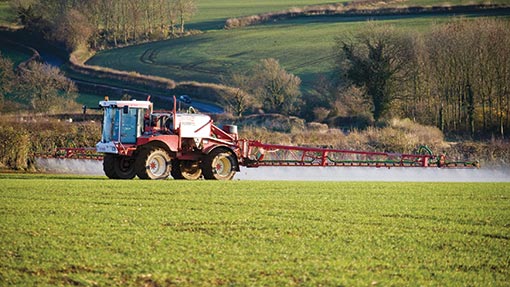Improve spraying efficiency to maximise spray window

There are precious few decent spray days around the key wheat fungicide timings, so growers must maximise operational efficiency to ensure products go on at the optimum timing.
Analysis of Met Office data at four sites in England over the past three years by Bayer CropScience has highlighted just how few spray days there are during the main T1 and T2 windows. In the worst month – April 2012 – there was just one spray day within the T1 slot of 15-30 April at Cambridgeshire and Hampshire sites and two days in Shropshire.
The 2012 season may have been an extreme case, but as our weather becomes more unpredictable it is unlikely to be the last and highlights how easily optimum spray timings can be missed, compromising efficacy, says Bayer CropScience’s Mike Abram.
What is a spray day?
- Bayer CropScience defines a spray day as one where there is nil/trace rainfall (<0.1mm) and average wind speed is 10km/h or less (Beaufort Force 3).
“Most growers need about three days to get around all of their major crop area [ie wheat] at a particular timing, so if you only get one or two spray days at the T1 or T2 window it’s almost certain some crops won’t get sprayed at the ideal time.”
Missing the optimum timing has a significant impact on disease control and yield, warns Bayer CropScience’s commercial technical manager Gareth Bubb.
Velcourt trials in Norfolk in 2012 showed a week’s delay to T2 applications of Aviator 235 Xpro (prothioconazole + bixafen) at 1 litre/ha reduced septoria control from 94% to 87% and knocked 0.2t/ha off the yield benefit over untreated crops. A three-week delay saw control drop a further 3% and cut the yield benefit by 0.3t/ha.
“There’s no substitute for getting the right product on at the right time,” Mr Bubb says. “If timing is delayed the only way to get similar efficacy is to increase the dose, but that’s still not as effective as getting on at the optimum stage.”
Covering ground
It is therefore vital growers maximise spraying efficiency by using new sprayer technology and advanced fungicide formulations with better rainfastness and a wider application window.
David Hildred of spraying contractors Boston Crop Sprayers, which regularly treats 10,000ha every season with one machine, says the biggest technological advance has been GPS automated boom shut-off. This helps maintain travel speeds throughout the day and significantly improves working efficiency. Automated boom levelling and auto-rinse systems also deliver huge benefits, as do the many features designed to reduce operator fatigue.
It is crucial to minimise sprayer downtime and keep machines working as long as possible. Improving access to water and chemical supplies through bowsers is one way of doing this, but using newer “one-can” fungicides that can be applied at lower water volumes and higher forward speeds can also make a big difference, he says.
“These also reduce the need for mix partners. Typically a modern sprayer can mix a tank load in under 10 minutes but it still leaves all the rinsing and disposal of the packaging.”
Spraying efficiency tips
- Cut filling times: Plan spraying schedule carefully and ensure everything is ready. “One-pack” formulations are quicker than complex mixes and reduce washing time
- Use bowsers
- Plan cropping: block similar varieties, target at-risk varieties first, put resistant varieties furthest away
- Reducing water volumes increases hectares per tank load
- Low-drift air induction nozzles can extend spray window
- Increase forward speeds where appropriate
- Consider new formulation technology (eg Xpro) with better rainfastness (within minutes) and more flexible application
Case study: Richard Peck, Sentry
Dorset-based farmer and head of procurement at Sentry, Richard Peck, says maximising spraying efficiency requires attention to detail in every aspect of what you do.
Sentry’s six south-west farms have a total of 620ha (1,500 acres) of wheat to spray each season, spread over a 50-mile radius.
This is all done by a 24m, 4,000-litre capacity John Deere 840i trailed sprayer, using full GPS guidance and automatic boom on/off.
“There’s no denying it is tight getting products on at the optimum timing, but we can’t afford to have excess capacity,” says Mr Peck.
“We’ve got a good operator and can normally spray up to 400 acres a day, so can get around all of our wheat in three to four days. But you can soon lose time to the weather, so we have to do all we can to get the most out of the machine and minimise downtime.”
That means a focus on everything from block cropping a select few varieties (Kielder, Relay and JB Diego this year) to ensuring all water supply couplings are the same on every farm. Having water and chemical supplies ready to go from the outset is key, as is keeping the sprayer and tractor in good working order, he says.
“Our sprayer allows us to go as fast as conditions allow, but our biggest challenge is topography. Steep slopes limit what we can do safely and also prevent us going bigger than 24m boom widths.”
Fungicide choice at T1/T2 is kept simple to further speed the filling process and usually consists of straight Aviator or Variano Xpro (bixafen, fluoxastrobin + prothioconazole), applied using low-drift nozzles at a water volume of 100 litres/ha.
“Septoria is our main threat and these products do work well against it, plus they have allowed us to go on in conditions where we wouldn’t have risked other products.”

